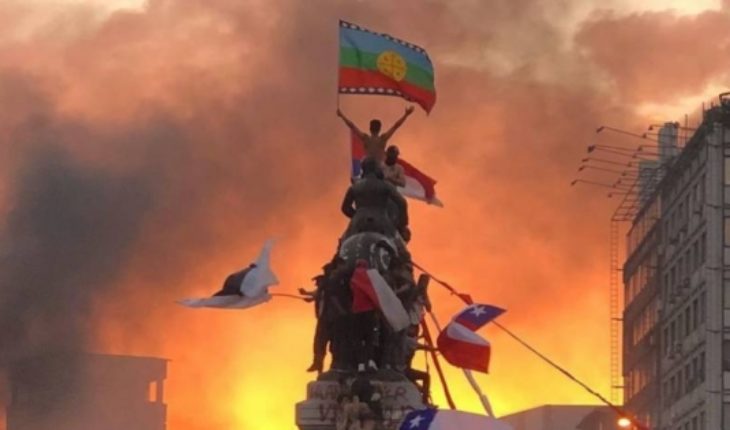Finally, after a marathon 15-hour trading day, officialism and opposition sealed the agreement for a constituent route, a key announcement to begin putting the epitaph to the 1980 Constitution.
At the congressheadquarters in Santiago, parliamentarians communicated after 2 a.m. the details of a historic agreement, which La Moneda monitored only in the distance, and which seeks to give a way out of the acute social and political crisis that this Friday celebrates exactly one month. The understanding “for peace and the new Constitution” came close to failure, and at times came to a standstill, first because of the right’s position to close to the idea of an entrance plebiscite, a request that was impassable for the opposition, because it allowed the discussion to be opened on the mechanism.
Another complex point was the demands of the leftmost wing of the opposition to demand yes or yes a Constituent Assembly, the formula claimed by the bloc from dc to the Broad Front, in last Tuesday’s unprecedented unitary statement.
Consensus
However, although the positions seemed irreconcilable, after 3:30 p.m. the trafficking continued in the parliamentary building. Dialogue from udI to the Broad Front – only self-marginated the Communist Party – was reactivated and around 21 hours all indicated that white smoke would finally come out.
Even details of the understanding arose, with the option of an entry plebiscite and the Constituent Assembly alternative in consultation, two concepts that 24 hours earlier seemed absolutely out of the right orbit.
Consensus also represents a clear step forward in terms of the mechanism, as both sides agreed that two alternatives, now referred to as Citizen Assemblies, should be consulted in this plebiscite: a Constitutional Convention (100% elected delegates) which in fact corresponds to the Constituent Assembly; or a Joint Constitutional Assembly or Convention, composed of 50% of current parliamentarians and 50% of elected delegates. There will also be an exit or ratification.
Senator Jacqueline van Rysselberghe.
The 50%-50% formula also represents a step forward from Chile Vamos’s initial response, which had offered a mechanism of 40% of current parliamentarians, 40% of elected delegates and 20% of citizens appointed by the same assembly, a proposal rejected outright by the opposition, which rightly described it as a “joke for democracy”.
The plan also envisages that the plebiscite would take place in April 2020 and the elections for the assembly responsible for drafting the new Fundamental Charter will be finalised together with the municipal and governors’ elections in October next year, under the rules of the election of deputies.
In case of choosing either mechanism, the Citizen Assembly will have the mission to draft the new Constitution from scratch, but with agreements that will require a quorum of 2/3.
The quorum crux
This was the point that marked the last pit of the negotiation. At 21 hours, when the microphones were installed in a room of the former Congress to give the announcement, Mario Desbordes, president of RN, a party that has been instrumental in generating this new scenario, announced that in another half hour there would be a new meeting.
“There are several things on which we agree; it’s very different from in the morning, when there was an abyss,” he said, putting the day on more suspense.
Mario Desbordes.
The stopper stone was now in the quorum, because the officialism raised that if the assembly in charge of the New Constitution does not reach consensus in certain chapters, then the version recorded in the current Magna Carta would prevail, that is, the 1980 Constitution. This requirement was clearly unacceptable to the opposition, which requires starting from scratch, like a blank sheet, without the respite from the text promulgated by the dictatorship of Augusto Pinochet. With the phrase “the new Constitution shall govern at the time of its promulgation and publication, with the current Constitution being organically repealed,” the point was settled.
Just around midnight, PPD Senator Felipe Harboe reported that officialism had accepted an intermediate proposal, to unravel quorum stumbling, subtracting only the wording of the agreement. “The days of the Constitution of 1980 are numbered,” the vice president of the Senate, PS Alfonso de Urresti, summed up at that time. “The 1980 Constitution begins to die,” ppd president Heraldo Muñoz supplemented.
Just at 02:24 hours came the ad classified as “historic” by Senate President Jaime Quintana (PPD), who presided over the tester accompanied by the helmsman RN Mario Desbordes, PS Alfonso de Urresti, President of the Democratic Revolution Catalina Pérez, Social Convergence Deputy Gabriel Boric and PPDs Heraldo Muñoz and Felipe Harboe, plus UDI helmsmans Jacqueline van Rysselberghe and PS Alvaro Elizalde, and flanked by the rest of parliamentarians.





